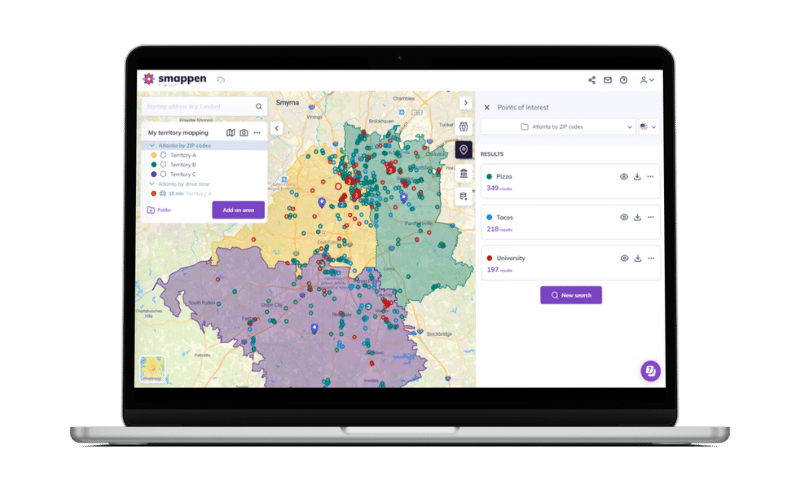You already know just how valuable location intelligence can be for your business, but haven’t yet been able to implement it. Or maybe you’re still on the fence, because you look at this new process and think “How on Earth am I ever going to make this work?” Don’t worry. Despite how tough the location intelligence challenges you’re facing are, the benefits are more than worth the effort.
Now let’s explore some of these challenges and see how you can get ahead of them.
Lack of data
If you’ve never used location intelligence before, you might not even know where to start. You know it can be a huge asset to everyone, including your marketers, the logistics team, and your executives. The tools you’re already using might not have the features you need for location intelligence, but this can be made worse by a lack of data — the first location challenge you’ll usually run into.
Unless your organization is just starting out, you’ll have more customer data than you know what to do with. But you might not know how to turn that data into location intelligence or aren’t yet collecting the right data.
How to beat this challenge
If you don’t have any location intelligence data whatsoever, then you need to get some. That can mean having your marketers or data engineers create new ways to collect data on your customers or even using free resources and databases — at least until you can get your own data.
For example, the U.S. Census Bureau has a website that lets you explore census data for free, allowing you to get insights into your ideal customer and their behaviors. And if you want to do more with that data, you can use a tool like Smappen to lay it out on a map. You could, for instance, see demographic information for a particular region, color-code it, and compare it to other areas.
Privacy and consent
If you use any kind of software to power your marketing initiatives, you know that changes around privacy and consent laws can completely decimate them. Everything from email marketing to foot traffic data can be impacted by a single update to a privacy law — like the EU’s GDPR. These changes are one of the biggest challenges you’ll face when working with location intelligence. You’ll get used to a certain level of granularity with data, only for that to disappear seemingly overnight.
This can send people scrambling as they try to find new ways to demonstrate the effectiveness of their projects, research their marketing campaigns, and better serve their customers.
How to beat this challenge
In some cases, the only thing you can do is stay up to date on privacy and consent laws. If you can see changes to specific laws like GDRP coming, you’ll have time to adapt your strategy.
Otherwise, many marketers and analysts are switching to first-party data — collected directly from a customer with their permission — to make themselves more resilient to these changes. You can do this through surveys, permission forms on your website, and even in exchange for valuable content and other assets.
Being properly equipped to leverage location intelligence
Like many things, location intelligence is a lot easier when you have the right tool for the job. Many marketers, analysts, and business owners may start with a patchwork solution combining spreadsheets, free tools like Google Maps, and a drive time tool or similar app. However, they’re often caught trying to shore up the weaknesses of each platform, meaning any workflows relying on location intelligence become slower and less reliable.
How to beat this challenge
Get a single tool that can do it all, like Smappen. Smappen is an all-in-one location intelligence platform that lets you create catchment areas, calculate drive times, research demographics, and more. Consolidate every aspect of your location intelligence workflows into a single tool with Smappen.
Curious? You can try the app for free right here.

Too many spreadsheets
Spreadsheets are still the backbone of many workflows. Marketers use them for planning and reporting on their campaigns, business owners use them for everything from payroll to business strategy, and analysts practically live in them. But while spreadsheets are incredibly convenient for storing and sifting through data, they’re not well-suited to location intelligence. That’s because you usually need to see your data represented on a map to really understand it. Going through a list of addresses might give you some insights you can use, but seeing them represented as color-coded areas in your city can instantly create an “aha!” moment that completely changes the game for your team.
How to beat this challenge
While integrations and widgets can help you get a handle on your spreadsheets, you need dedicated location intelligence software — like Smappen — to really make the most of it. When you can quickly draw out maps, catchment areas, and franchise territories, you’ll find that you can do a whole lot more with the data trapped in your spreadsheets.
Keeping up with evolving data
Even if none of these challenges is an issue for you, there’s still one struggle you’ll have to deal with: new data. As your business grows, so will your customer base — and your list of prospects. Whatever location intelligence system you use will have to handle growing databases. That growth will involve both an increase in the number of records you’re dealing with and the complexity of your data. Some systems — like spreadsheets — can’t handle this evolution, leaving you stuck with more manual work to keep your data up to date.
How to beat this challenge
The best way to keep up with a growing database is to use a platform that can scale with it. While spreadsheets and other free tools might cut it for a time, you’ll eventually find yourself needing to upgrade to more specialized — and expensive — solutions. But if you get a dedicated location intelligence tool, you can stay ahead of evolving data without building your own massive data infrastructure. Smappen, for example, automatically updates every time the U.S. Census is released, and point of interest data is updated every two months.
Location intelligence can be a no-brainer
Like any other strategy that depends on complex data, using location intelligence can be challenging. Whether you’re dealing with an initial lack of data, inadequate tools, or too many spreadsheets, remember that even small improvements to your process can make a huge difference in the long run. Additionally, you should be considering dedicated location intelligence platforms instead of tools that only handle parts of the location intelligence process. Smappen is a great choice, and you can start using it for free.

